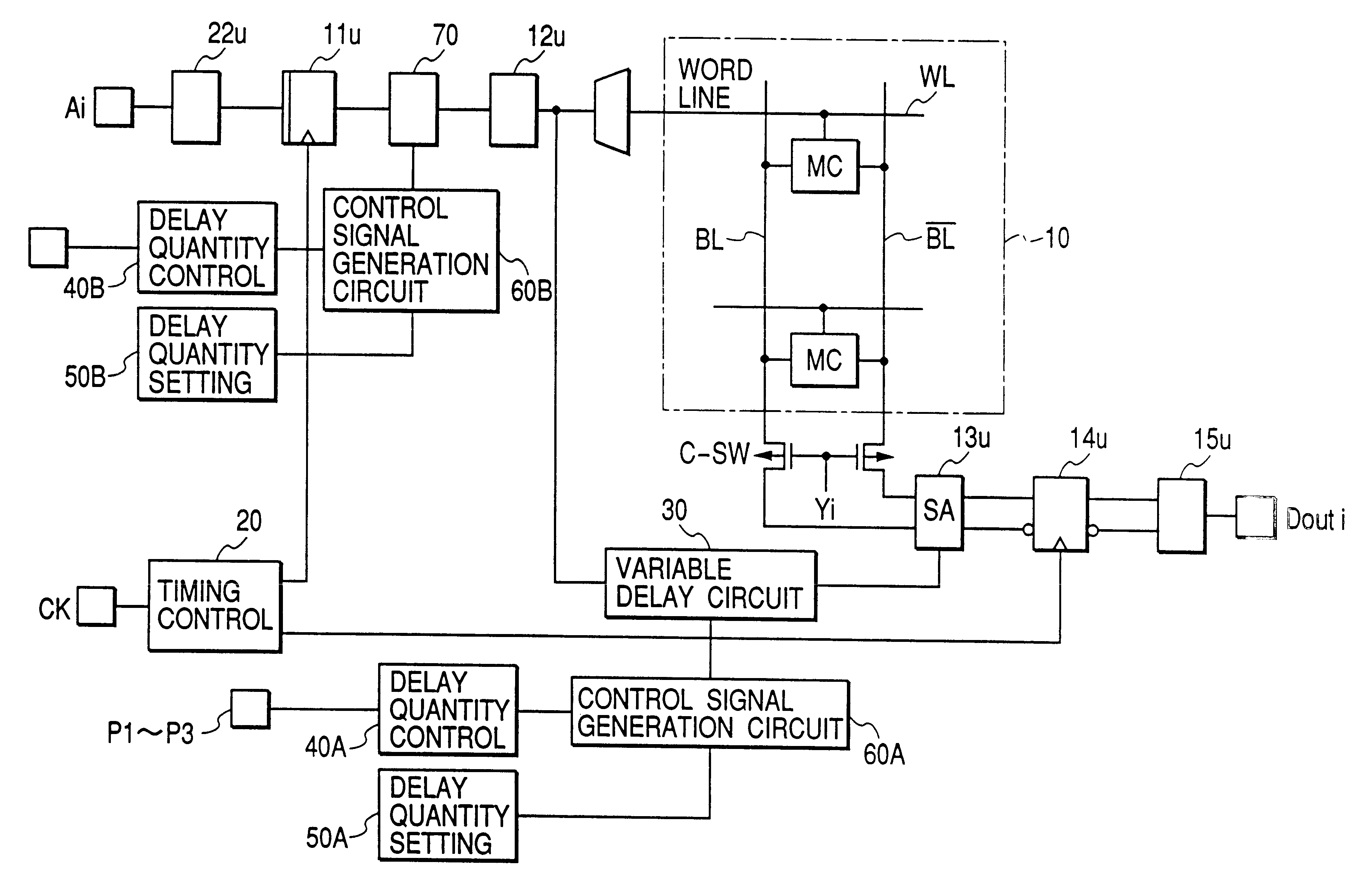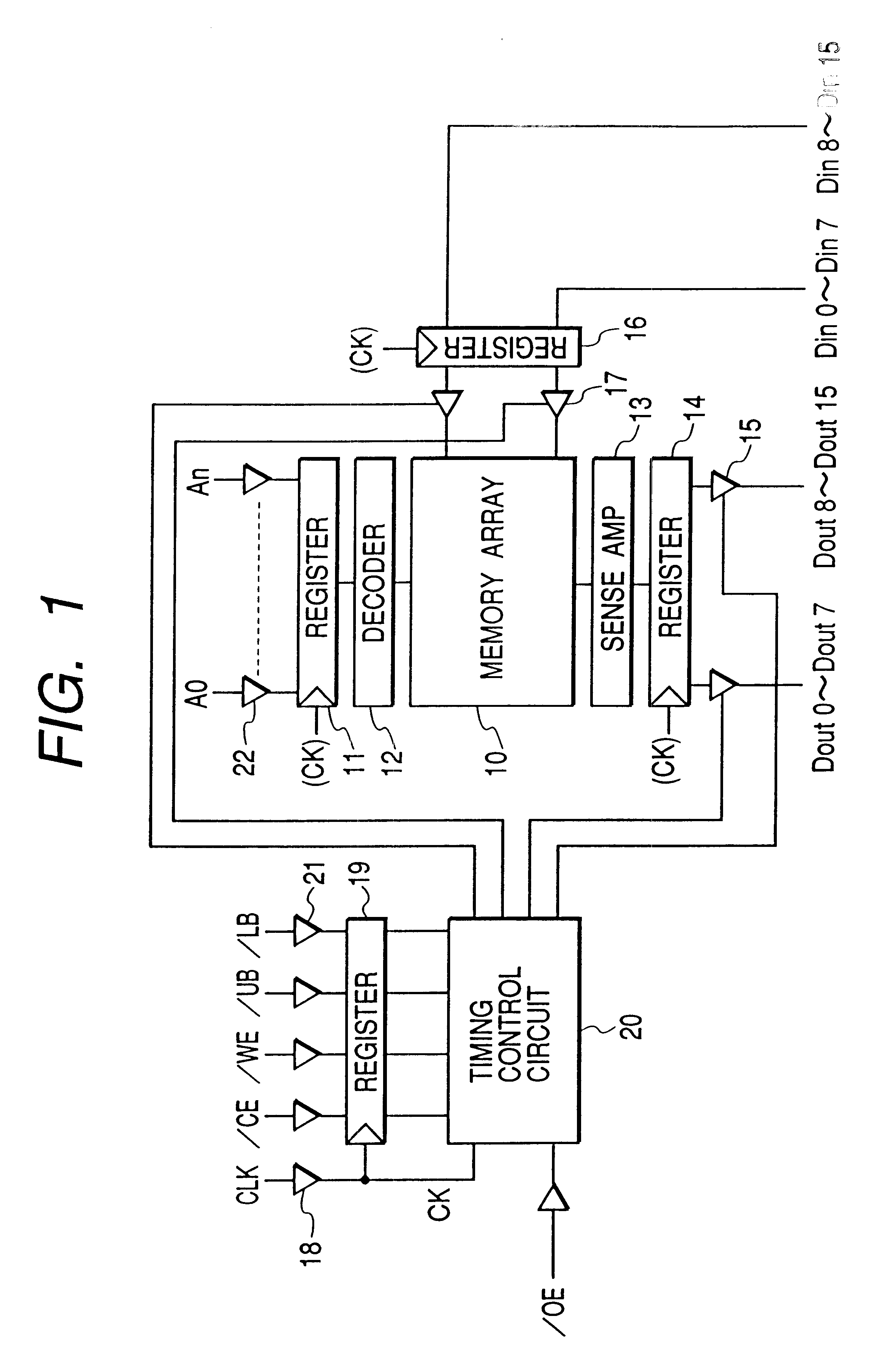High speed semiconductor memory device with short word line switching time
a semiconductor memory and line switching technology, applied in semiconductor devices, digital storage, instruments, etc., can solve the problems of difficult to precisely establish the timing between the read timing of the memory cell, and the increase in the delay time of the sense amplifier, so as to improve the operation speed of the sense amplifier and reduce the access time and cycle time of the memory cell. , the effect of improving the operation speed
- Summary
- Abstract
- Description
- Claims
- Application Information
AI Technical Summary
Benefits of technology
Problems solved by technology
Method used
Image
Examples
first embodiment
FIG. 1 is a schematic structural view showing a clock synchronization type static RAM to which the present invention is applied appropriately.
Referring to FIG. 1, reference numeral 10 denotes a memory array that has a plurality of memory cells disposed in matrix, a plurality of word lines to which selection terminals of the memory cells of the same row are connected, and a plurality of bit lines to which input / output terminals of the memory cells of the same column are connected. Reference numeral 11 denotes an address register for latching input address signals A0 to An in synchronism with a clock signal CK. Reference numeral 12 denotes an address decoder for decoding the latched address signal and selecting the corresponding word line inside the memory array 10. Reference numeral 13 denotes a sense amplifier line comprising a plurality of sense amplification circuits each being disposed for each bit line pair to which the selected memory cell is connected, and for amplifying a pot...
second embodiment
In this second embodiment, the variable pulse generation circuit 70 is interposed between the address register 11u and the address pre-decoder 12u as shown in FIG. 9. The variable pulse generation circuit 70 renders the fall of the internal address signal supplied to the pre-decoder 12u. In this way, a signal having a variable pulse width is generated. In order to vary the pulse width in this variable pulse generation circuit 70 and to conduct the test of the memory, this embodiment includes a second delay quantity controlling circuit 40B, a second delay quantity setting circuit 50B for setting the delay quantity determined on the basis of the test result and a second control signal generation circuit 60B for generating a control signal for the variable pulse generation circuit 70.
The variable pulse generation circuit 70 is the one that has substantially the same circuit construction as the variable delay circuit 30 in the first embodiment shown in FIG. 5. The second delay quantity ...
fourth embodiment
In this fourth embodiment, the control signal / WE representing the data read or write operation is supplied to the variable pulse generation circuit 70" through the buffer 21u so that the pulse width (select time) can be changed between the data read operation and the data write operation as shown in FIG. 14. To independently adjust the pulse width of the word line between the read operation and the write operation, this embodiment includes a third delay quantity controlling circuit 40C, a third delay quantity setting circuit 50C and a third control signal generation circuit 60C, each being for the write operation and corresponding to the second delay quantity controlling circuit 40B, the second delay quantity setting circuit 50B and the second control signal generation quantity 60B for the read operation, besides these circuits 40B, 50B and 60B.
Incidentally, the word line select time must be shorter in the data write operation than in the data read operation. However, since the rec...
PUM
 Login to View More
Login to View More Abstract
Description
Claims
Application Information
 Login to View More
Login to View More - R&D
- Intellectual Property
- Life Sciences
- Materials
- Tech Scout
- Unparalleled Data Quality
- Higher Quality Content
- 60% Fewer Hallucinations
Browse by: Latest US Patents, China's latest patents, Technical Efficacy Thesaurus, Application Domain, Technology Topic, Popular Technical Reports.
© 2025 PatSnap. All rights reserved.Legal|Privacy policy|Modern Slavery Act Transparency Statement|Sitemap|About US| Contact US: help@patsnap.com



